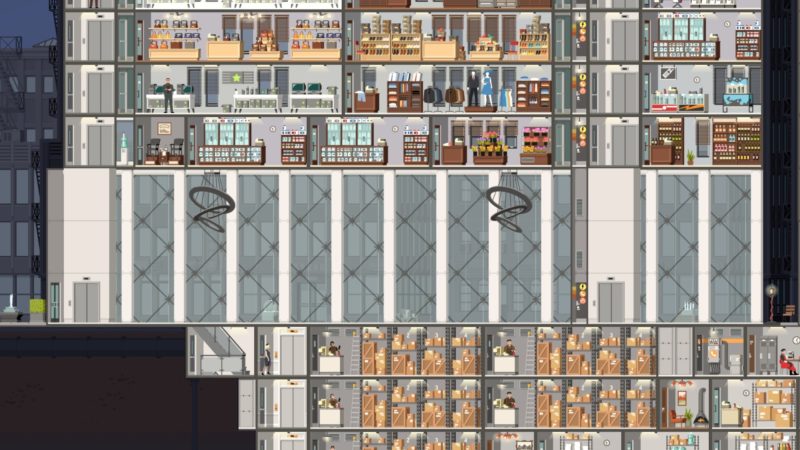
Project Highrise is a micro-management game by Kasedo Games wherein you create a building, lease the spaces in the buildings to tenants, and try to keep a positive flow of income. A fair warning, this game requires both the ability to micro-manage and patience, so if you have neither of these qualities then I am fairly certain you will only find this game rage-inducing. If you have both of these, then continue reading.
Every day at midnight, you will receive the net profits generated by the building (the income from the tenants minus the operating cost of things like the electricity generator). Ideally, you want the income generated to exceed the operating costs of the building. When midnight comes around, the game will pause and display the total income generated, the total operating costs of the building, and the net profit.

There are 4 categories of tenants: apartments, stores, offices, and food stalls/restaurants. Within each category there is a type of space you can build for each of these: small, medium, big, advanced, etc. Putting down a space for a type of tenant is free—provided you have enough space on the floor you are putting it on—but choosing a tenant has a cost.
After placing a space for a small apartment, medium restaurant, etc. you need to find a tenant to use the space. You can do this by clicking on the space, which will display a list of all available tenants that are interested in using the space. A fair warning though, usually the more a tenant is willing to pay, the more services they will be expecting from you.
To give tenants electricity, water, phone lines, cable TV, gas, and/or AC, you first need to build a generator of that type. Then, you need to create a line between the generator and the space the tenant is using. Moving the path left or right has a one-time cost, but moving the path up or down has a daily cost. Additionally, a generator can only support so many tenants before you need to either upgrade the generator or place down a new one.

There are also other services that the various tenants will expect. For example, all types of office tenants usually want a file storage service. Luckily, the services expected from a specific type of tenant are grouped together in a category titled “services expected by tenants.” There are also some services that all types of tenants will expect, such as a trash bin on their floor and room maintenance. For most services, you only need to build one station for that service to serve all tenants in the building. The exception to this is storage bays. Storage bays only serve a set number of tenants before you need to build a new one. Luckily, from what I could see, only stores require this service.
Because stores are the only type of tenant that require storage bays, it might be tempting to not build space for them. But some of the tenants require certain stores to be present in your building before they will move in. For example, a medical office will only consider setting up in your building if you have given space to a drug store. As you can probably guess, medical offices—and other offices that require a type of store to be present in the building—pay substantially more in income than offices that don’t need a type of store to be present.

I actually found offices to be a good starting point when you begin a new game. Their early versions pay more than early versions of food stalls/restaurants and don’t require as many services as apartments or stores. More prestigious offices will usually require a certain type of store to be in the building however. They also require certain types of restaurants (usually the description says variation in restaurants that serve say, lunch).
When you start a new game, you only have access to small spaces for offices, apartments, and food stalls/restaurants. However, if you have enough tenants present in your building, your star rating will go up. Usually your star rating is proportional to the number of tenants present in your building, but various things such as buying paintings for the building can also increase your star rating. As your star rating goes up, you gain access to bigger spaces for tenants who usually pay more than the starting tenants and the services these tenants expect.
Aside from starting a new game, there are also scenarios that you can play through. Each of these scenarios has 3 goals for you to accomplish. To begin with, you only have access to one scenario, but if you complete at least 1 of the 3 goals in that scenario, you will unlock the next scenario. From what I can tell, all the scenarios work like this; complete at least 1 goal in a scenario to unlock the next scenario.
Luckily, the game also has a tutorial mode to explain the basics of the game. I HIGHLY recommend playing this before starting the game.
Overall while I sometimes got frustrated with this game, I though it was well done. As such, I think a fair rating for it would be 8/10.
Check Out the Project Highrise: Architect’s Edition Trailer:
Project Highrise: Architect’s Edition is available for PlayStation 4, Xbox One, Nintendo Switch, PC, and Mac.
PlayStation 4 Review
I am a recent Computer Science/Game Development Programming Chapman University Graduate. I am a life long enthusiast of computer/video gaming and my favorite game genres are adventure, choice-driven stories, fighting, and racing. My favorite game/movie series include but aren't limited to 'Legend of Zelda'; 'Dragon Age'; 'Persona'; 'Sonic the Hedgehog'; 'Mario'; 'Metroid' ;'Megaman'; 'Naruto'; 'Batman'; 'Spiderman'; 'Star Wars'; and 'Star Trek.'





More Stories
GTA Online: A Safehouse in the Hills Heading to PlayStation, Xbox, and PC on December 10
S.T.A.L.K.E.R. 2: Heart of Chornobyl Review for PlayStation 5
Call of Duty: Black Ops 7 and Call of Duty: Warzone Season 01 Now Live along with RICOCHET Anti-Cheat Update